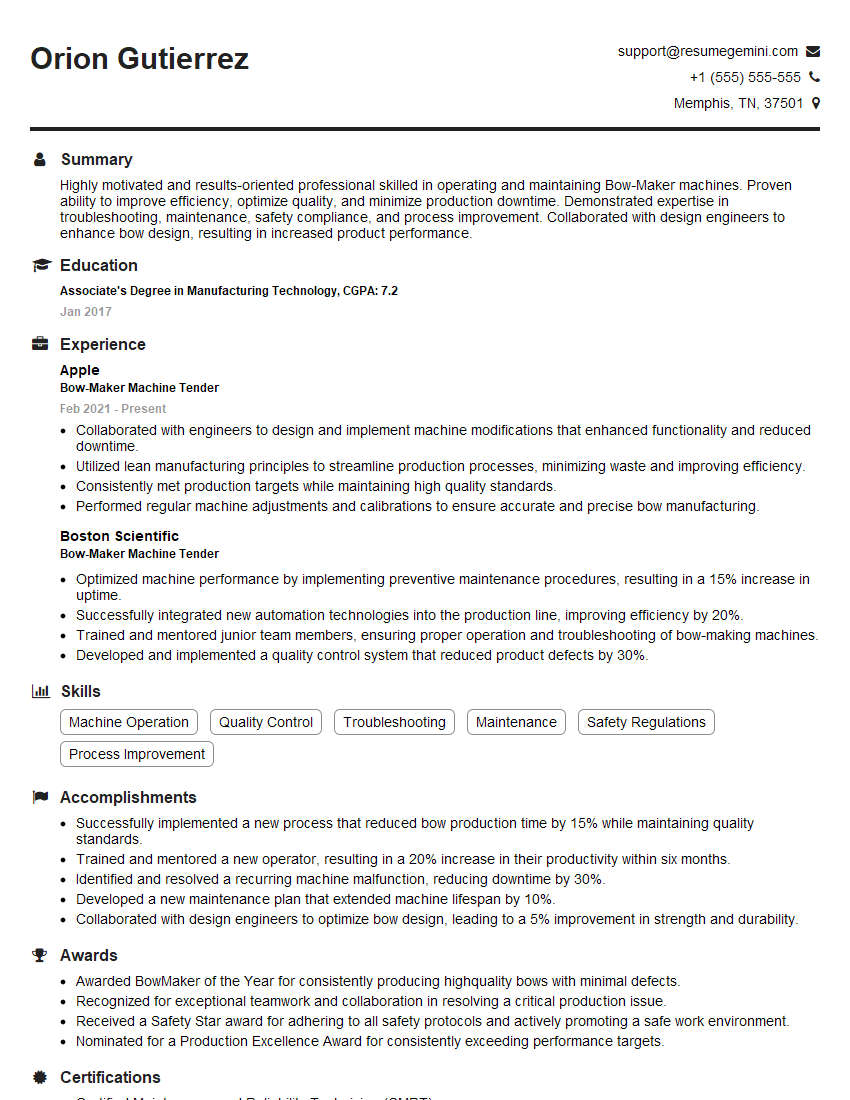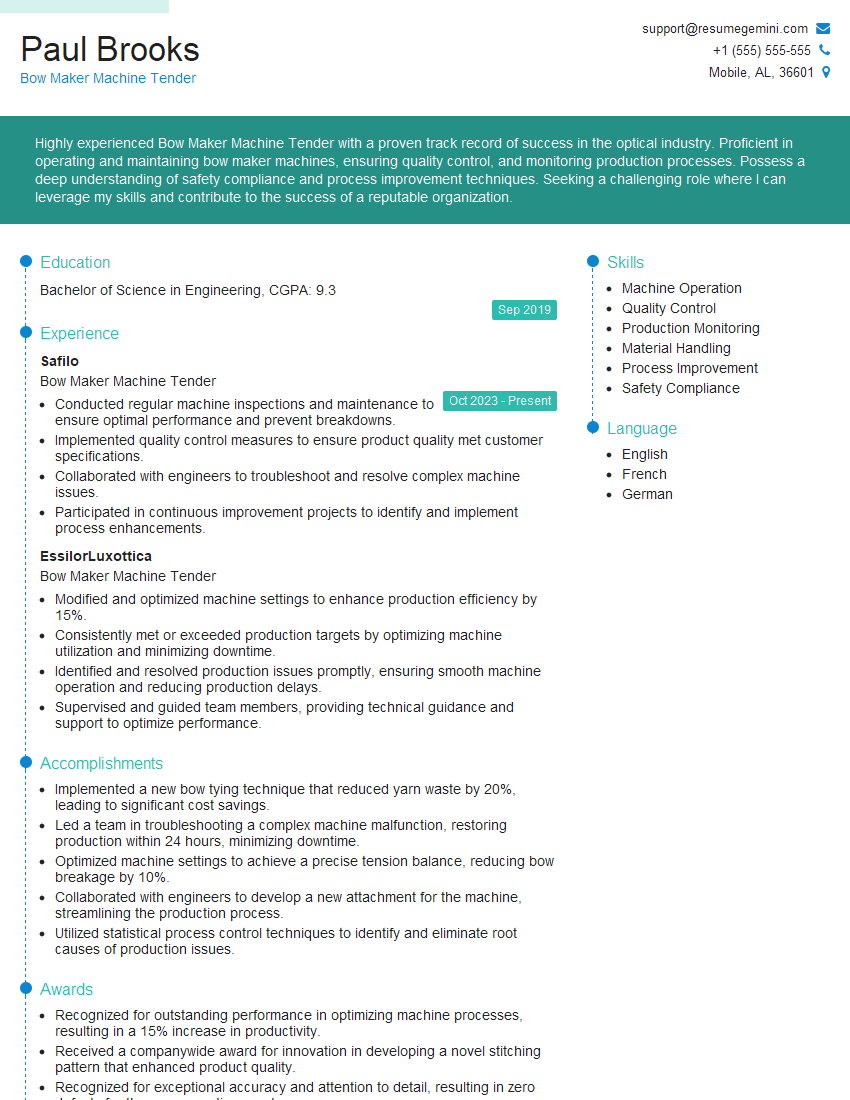Are you gearing up for a career shift or aiming to ace your next interview? Look no further! We’ve curated a comprehensive guide to help you crack the interview for the coveted Bow-Maker Machine Tender position. From understanding the key responsibilities to mastering the most commonly asked questions, this blog has you covered. So, buckle up and let’s embark on this journey together
Acing the interview is crucial, but landing one requires a compelling resume that gets you noticed. Crafting a professional document that highlights your skills and experience is the first step toward interview success. ResumeGemini can help you build a standout resume that gets you called in for that dream job.
Essential Interview Questions For Bow-Maker Machine Tender
1. What are the key components of a bow-maker machine and how do they work together?
The key components of a bow-maker machine include:
- Threading mechanism: This component guides the bowstring material onto the machine and helps create the desired tension.
- Tension control: This component ensures that the bowstring is wound with the correct tension and prevents it from becoming too loose or too tight.
- Bow-forming mechanism: This component shapes the bowstring into the desired shape and size.
- Finishing mechanism: This component adds any necessary finishing touches, such as applying a coating or sealant, to the bowstring.
These components work together to create a bowstring that meets the desired specifications.
2. Describe the different types of bowstrings and their respective applications.
Synthetic bowstrings
- Dacron: durable and affordable, suitable for both recurve and compound bows
- Dyneema: high-performance material that offers low stretch and high strength
- Spectra: another high-performance material known for its strength and durability
Natural bowstrings
- Sinew: made from animal tendons, offers a traditional feel and good performance
- Hemp: a natural fiber that is strong and durable, often used in traditional archery
- Rawhide: made from animal skin, provides good strength and a unique feel
3. What are the common defects that can occur during the bow-making process and how can they be prevented?
Common defects that can occur during the bow-making process include:
- Improper tension: Can lead to the bowstring being too loose or too tight, affecting its performance and durability.
- Incorrect shape: The bowstring may not form the desired shape, which can affect the accuracy and consistency of the bow.
- Fraying or breakage: The bowstring may fray or break due to excessive wear or improper handling.
- Material defects: The bowstring material may have defects that weaken its structure or performance.
These defects can be prevented by:
- Using high-quality materials and components
- Following the manufacturer’s instructions carefully
- Properly maintaining and storing the bow-maker machine
- Regularly inspecting the bowstring for any signs of damage or wear
4. Describe the safety precautions that should be followed when operating a bow-maker machine.
The following safety precautions should be followed when operating a bow-maker machine:
- Wear appropriate safety gear, including safety glasses and gloves.
- Ensure that the machine is properly grounded and connected to a power source.
- Keep the work area clean and free of debris.
- Never attempt to operate the machine if it is damaged or not functioning properly.
- Be aware of the moving parts of the machine and keep hands clear.
- Follow the manufacturer’s instructions carefully.
5. How do you troubleshoot common problems with a bow-maker machine?
Common problems with a bow-maker machine and their troubleshooting steps include:
- Machine not turning on: Check the power source, wiring, and fuses.
- Incorrect tension: Adjust the tension control settings.
- Bowstring not forming properly: Check the bow-forming mechanism and ensure it is properly adjusted.
- Fraying or breakage: Inspect the bowstring for damage and replace if necessary.
- Excessive noise or vibration: Check for loose components or misalignment and tighten or adjust as needed.
6. What maintenance tasks are required to keep a bow-maker machine running optimally?
Regular maintenance tasks for a bow-maker machine include:
- Cleaning the machine regularly to remove any dust or debris.
- Lubricating moving parts as per the manufacturer’s instructions.
- Inspecting the machine for any signs of damage or wear.
- Calibrating the machine periodically to ensure accuracy.
- Following the manufacturer’s recommended maintenance schedule.
7. How do you calculate the length of a bowstring for a specific bow?
To calculate the length of a bowstring for a specific bow, you can use the following formula:
Bowstring length = (2 × Draw length) + (2 × Brace height) + (2 × Number of twists)
- Draw length: The distance between the nocking point on the bowstring and the anchor point on the archer’s face when the bow is fully drawn.
- Brace height: The distance between the string and the grip of the bow when the bow is unstrung.
- Number of twists: The number of twists in the bowstring, which can affect its length.
8. What factors affect the performance of a bowstring?
The performance of a bowstring is influenced by several factors, including:
- Material: The material used to make the bowstring, such as synthetic or natural fibers, can affect its strength, durability, and stretch.
- Construction: The way the bowstring is constructed, such as the number of strands and the type of serving, can impact its performance.
- Condition: The condition of the bowstring, including any damage or wear, can affect its performance and safety.
- Maintenance: Proper maintenance, such as waxing and inspecting the bowstring, can help extend its lifespan and optimize its performance.
9. How do you ensure the quality of the bowstrings produced by the bow-maker machine?
To ensure the quality of bowstrings produced by the bow-maker machine, it is important to:
- Use high-quality materials and components.
- Follow the manufacturer’s instructions carefully.
- Calibrate and maintain the machine regularly.
- Inspect the bowstrings for any defects before use.
- Establish and follow quality control procedures.
10. What are the latest advancements in bow-making technology?
The bow-making industry has seen several advancements in recent years, including:
- Automated bow-making machines: These machines can produce bowstrings with greater precision and efficiency than manual methods.
- New materials: The development of new materials, such as high-performance synthetic fibers, has improved the strength and durability of bowstrings.
- Improved designs: Bowstring designs have been optimized to reduce stretch, increase stability, and enhance performance.
- Advanced quality control techniques: Non-destructive testing methods and other techniques are used to ensure the quality and safety of bowstrings.
Interviewers often ask about specific skills and experiences. With ResumeGemini‘s customizable templates, you can tailor your resume to showcase the skills most relevant to the position, making a powerful first impression. Also check out Resume Template specially tailored for Bow-Maker Machine Tender.
Career Expert Tips:
- Ace those interviews! Prepare effectively by reviewing the Top 50 Most Common Interview Questions on ResumeGemini.
- Navigate your job search with confidence! Explore a wide range of Career Tips on ResumeGemini. Learn about common challenges and recommendations to overcome them.
- Craft the perfect resume! Master the Art of Resume Writing with ResumeGemini’s guide. Showcase your unique qualifications and achievements effectively.
- Great Savings With New Year Deals and Discounts! In 2025, boost your job search and build your dream resume with ResumeGemini’s ATS optimized templates.
Researching the company and tailoring your answers is essential. Once you have a clear understanding of the Bow-Maker Machine Tender‘s requirements, you can use ResumeGemini to adjust your resume to perfectly match the job description.
Key Job Responsibilities
A Bow-Maker Machine Tender is a skilled individual responsible for operating and maintaining bow-making machines. Their primary duty is to ensure the efficient and safe production of bows for various applications. Here are the key job responsibilities of a Bow-Maker Machine Tender:
1. Machine Operation
Operate bow-making machines efficiently and safely, following established procedures and specifications.
- Set up and adjust machines according to design specifications.
- Monitor machine operation and make necessary adjustments to optimize production.
2. Quality Control
Inspect bows for quality and accuracy, ensuring they meet customer requirements.
- Conduct regular checks on bows for defects, dimensions, and finish.
- Identify and correct any deviations from specifications, maintaining high quality standards.
3. Maintenance and Troubleshooting
Maintain and troubleshoot bow-making machines to ensure optimal performance.
- Perform routine maintenance tasks, such as cleaning, lubrication, and adjustments.
- Troubleshoot machine malfunctions, identify the root cause, and implement solutions.
4. Material Management
Manage raw materials and finished goods, ensuring efficient utilization and quality control.
- Monitor raw material inventory levels and replenish as needed.
- Inspect incoming materials for defects and ensure they meet specifications.
Interview Tips
Preparing for an interview for a Bow-Maker Machine Tender position requires thorough research and a well-structured approach. Here are some interview tips to help you ace the interview:
1. Research the Company and Position
Before the interview, thoroughly research the company and the specific Bow-Maker Machine Tender position you are applying for. Understand their products, manufacturing processes, and company culture.
- Visit the company website and read about their history, values, and mission statement.
- Look for news articles and industry reports to gain insights into their operations and market position.
2. Highlight Relevant Skills and Experience
Tailor your resume and cover letter to highlight your skills and experience that are relevant to the job. Quantify your accomplishments and provide specific examples of your work.
- Emphasize your knowledge of bow-making machines, including their operation, maintenance, and troubleshooting.
- Showcase your experience in quality control, including your ability to inspect bows and identify defects.
3. Practice Common Interview Questions
Anticipate common interview questions and prepare your answers in advance. This will help you feel more confident and articulate during the interview.
- Prepare for questions about your technical skills, such as experience with specific bow-making machines or quality control procedures.
- Practice answering behavioral questions, such as how you handle challenges or work in a team environment.
4. Prepare Questions for the Interviewer
Asking thoughtful questions at the end of the interview shows your interest and engagement. Prepare questions that are specific to the position and the company, such as:
- What are the key performance indicators for this role?
- What are the company’s growth plans and how does this position contribute to those plans?
Next Step:
Armed with this knowledge, you’re now well-equipped to tackle the Bow-Maker Machine Tender interview with confidence. Remember, preparation is key. So, start crafting your resume, highlighting your relevant skills and experiences. Don’t be afraid to tailor your application to each specific job posting. With the right approach and a bit of practice, you’ll be well on your way to landing your dream job. Build your resume now from scratch or optimize your existing resume with ResumeGemini. Wish you luck in your career journey!

